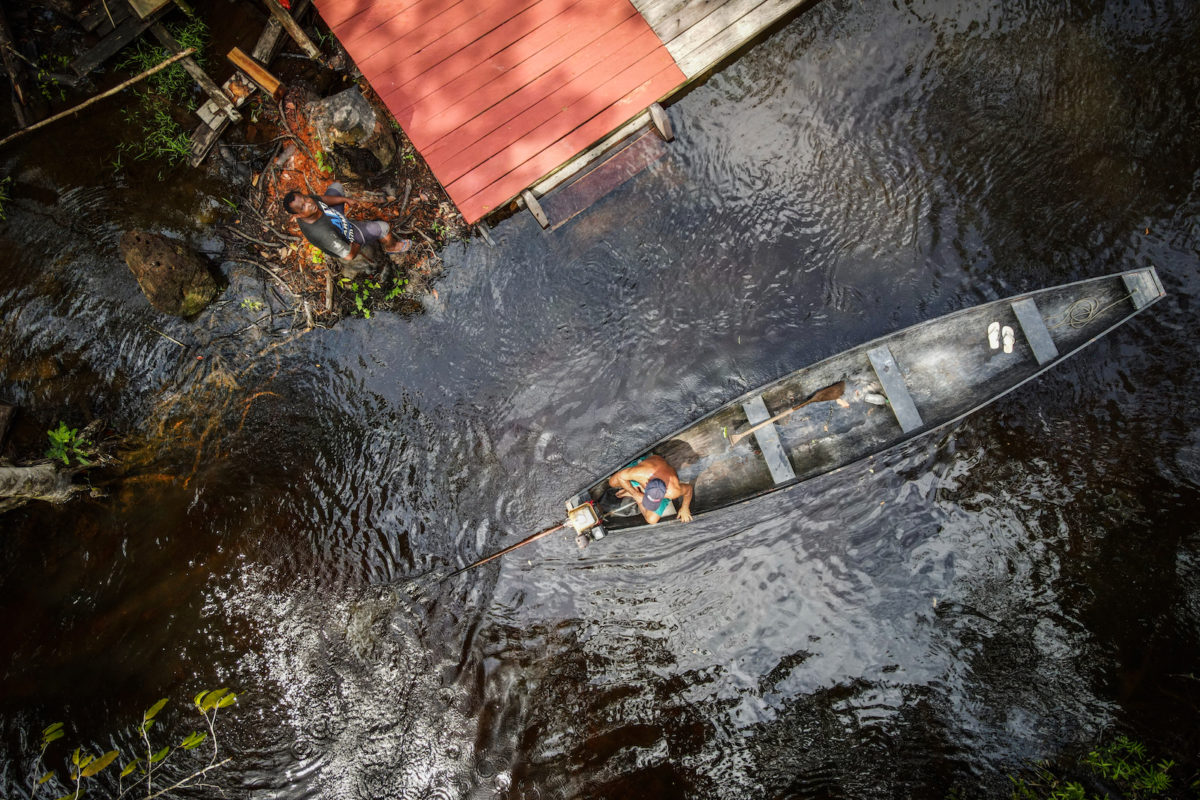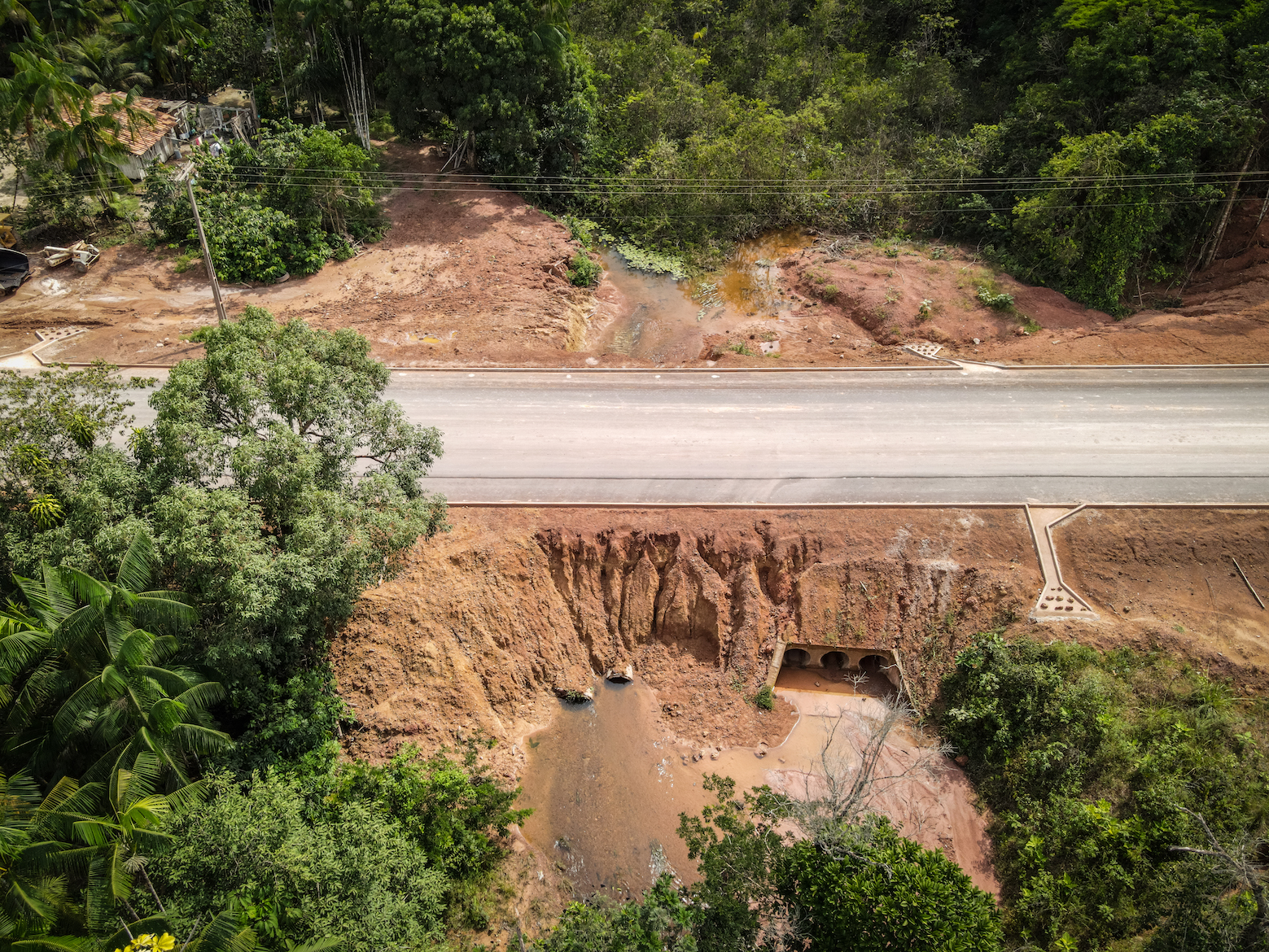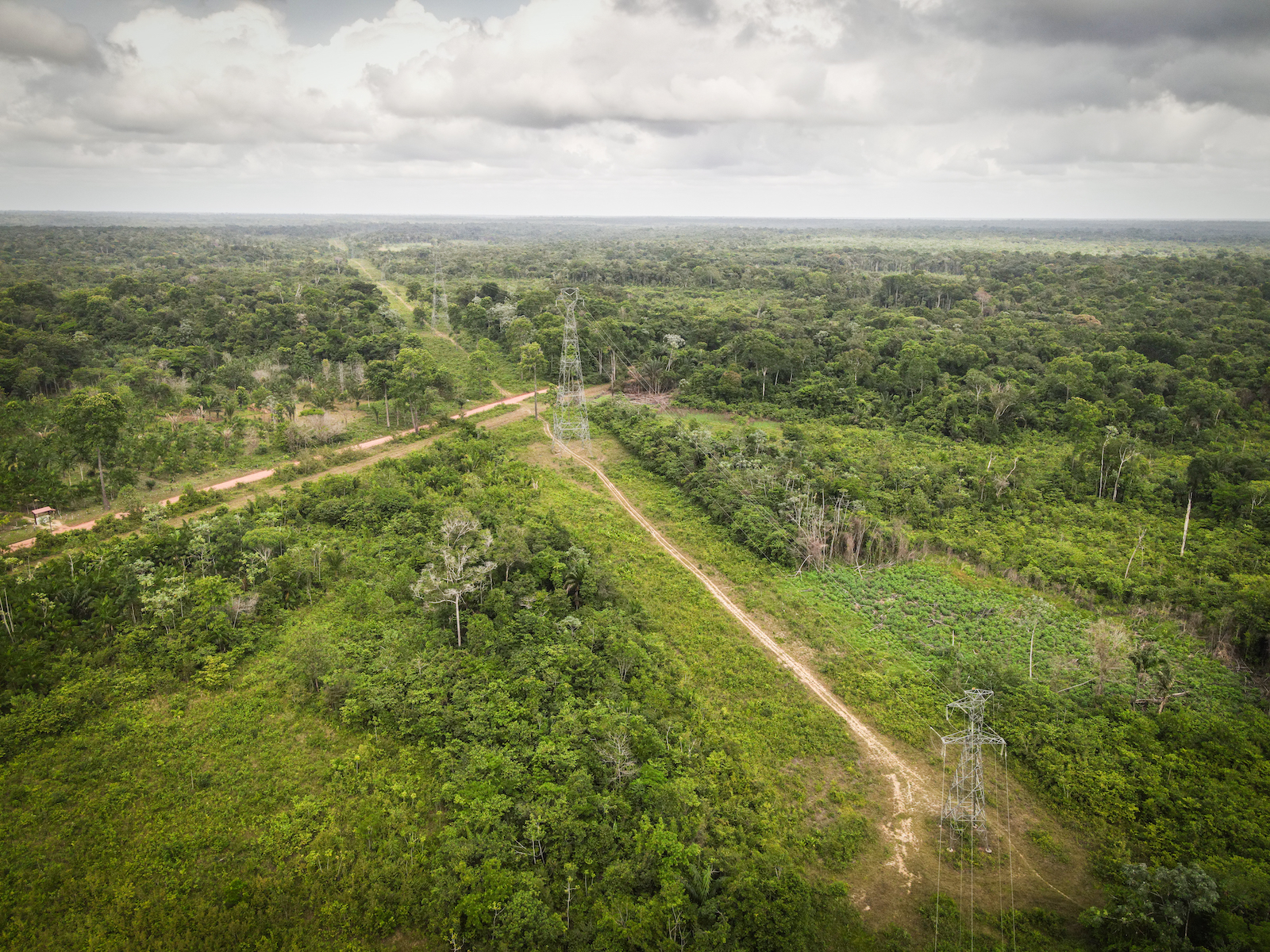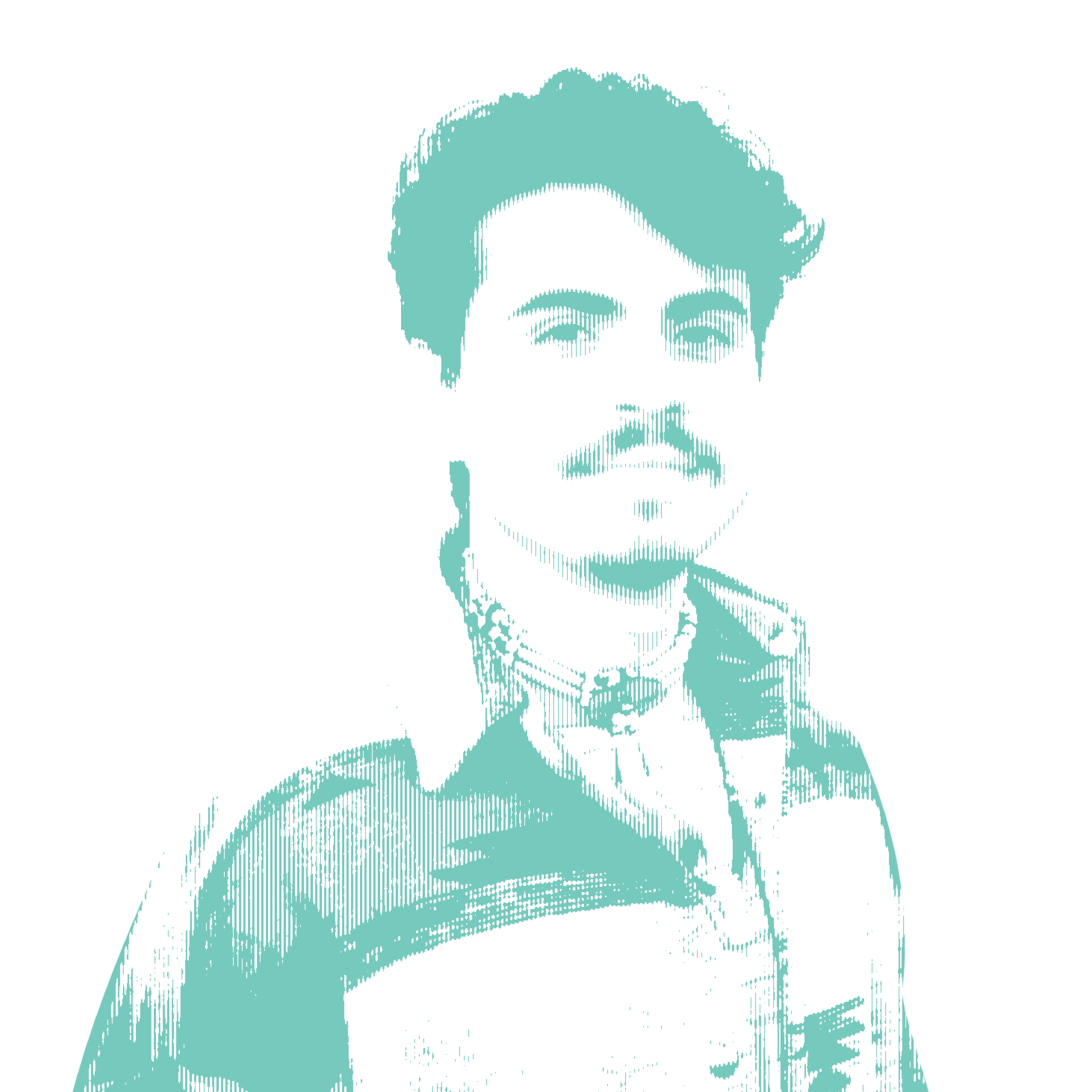
Sonia Castro says her family stayed in self-isolation for two months in the Jambuaçu Territory in Brazil’s Pará state. She recounts how they eventually fell ill, their condition worsening bit by bit without proper medical attention.
“[They were] one in each house, and after 30 days there was no way they could stay there any longer,” she says. “That’s when I had to call an ambulance, and they were transferred to Belém,” the state capital.
Castro is speaking in front of her wooden house, a solid structure painted forest green with white trim, located in the middle of the community of Ribeira. It’s one of Jambuaçu’s many quilombos, communities of quilombolas, the descendants of African slaves who settled in remote parts of Brazil to flee their oppressors starting in the 1500s. Quilombos are found throughout Brazil, including vast stretches of the Amazon Basin. But even though they often reside in remote, forested portions of the country, the quilombolas of Jambuaçu do not inhabit a bucolic landscape: they are surrounded by mining and processing activities, as well as large agribusiness ventures. The presence of which has been aggravated by the arrival of the novel coronavirus.
The other residents of her quilombo feared being infected with COVID-19, Castro says, so she had to fetch her kids sitting and waiting on a bridge on her way out of the community via motorboat — a daunting undertaking meant to prevent interaction with outsiders, but a far cry from the tight-knit nature of a community like Ribeira.

“I was desperate, because I thought that I would lose my children and I felt I was being discriminated against from some people because of this, that they didn’t want to have any more contact with me,” Castro says. “It became a kind of discussion, ‘her kids are really sick, they are going to infect other people.'”
Her experience is like that of many all over the world who have caught COVID-19, but the disease is particularly troubling in quilombos like Ribeira, part of a network of 15 such quilombos that make up the Jambuaçu Territory. At roughly 400 square kilometers (150 square miles), the territory is the size of the city of Philadelphia, but with a population of 728. While Jambuaçu has been home to quilombolas in some arrangement since at least the late 19th century, the region nevertheless suffers from a lack of government health care provisions, which has proved lethal during the pandemic. There’s a single, small clinic and one ambulance for the entire territory. Face masks and hand sanitizer are in short supply for the residents.
The land was once home to floodplain streams known as igarapés, where fisheries thrived, and the kind of forest biodiversity that was a hallmark of the eastern Amazon. For the quilombolas of Jambuaçu, forest and river resources are tied to their livelihoods. And while some of these ecosystems are still healthy and abundant, they’re increasingly under threat. The particular transformation they have experienced includes large-scale commercial activity: slurry pipelines, oil palm plantations, and a series of power lines cutting through hundreds of kilometers of forest and igarapé. All of these pose a range of risks to environmental and human health, and the COVID-19 pandemic has only served to amplify their effects.
Elias Silva, a longtime resident from the quilombo of Nossa Senhora das Graças, cites the unique threat posed by one of these commercial entities: a large oil palm firm, Marborges Agroindústria. With a hefty presence in the state of Pará, this multimillion-dollar agribusiness controls almost 7,000 hectares (17,300 acres) of oil palm plantation, with another 10,000 hectares (24,700 acres) for other aspects of its operation. Industrial oil palm cultivation may be most notorious for its deforestation potential, but its role in water pollution has also been highlighted in recent years globally. Moreover, according to authors of a 2013 study, oil palm firms in Pará state make particularly intensive use of chemical products such as fertilizers, herbicides, and pesticides. Given the proximity of Marborges’ plantations to rivers and streams, there is significant potential for contamination of water bodies by such substances.
“The igarapés that pass through the Marborges company [site] are the same that reach our territory here,” Silva says. “They release their waste, their poison along the way. We are reached here by water. The water here is our livelihood, where we fish, where we collect drinking water. And these days we are digging wells because the igarapés are contaminated.”
Marborges declined to speak with Mongabay after repeated requests for an interview.

Besides Marborges, mining companies also operate processing facilities with extensive slurry pipelines throughout the Jambuaçu Territory. Stretching 245 kilometers (150 mile), the pipelines of the transnational Norsk Hydro cut across the entire expanse of Jambuaçu. Hydro transports bauxite ore (the raw material for aluminum) from the city of Paragominas, in the southeast of the state, all the way to Barcarena, a city near the state capitol of Belém.
The Norwegian firm, of which the Norwegian government owns a 35% controlling share, has been sued several times by the Brazilian Federal Public Ministry (MPF) for damages to the environment and the residents of Barcarena. Most notably were two episodes, in which toxic red mud tailings broke free from containment infrastructure in 2014 and 2018. Hydro’s environmental transgressions in Barcarena affected five quilombola communities located downstream of it.
Some 60 km (37 miles) away in Jambuaçu Territory, the MPF has alleged that Hydro’s slurry pipeline has operated without an environmental license since 2014. This absence led the MPF to propose a settlement agreement with local residents in 2019, which would have compensated families residing in the territory due to impacts caused by Hydro. According to the MPF, however, the company rejected the agreement. In an addendum, the MPF says it considers the company’s position to be offensive “to the rights of the population and to constitutional and legal dictates, since the Quilombola Territory of Jambuaçu is a rare, culturally important collective.”
In response, Hydro says it maintains a frequent dialogue with the residents and communities of Jambuaçu and that it is currently developing an impact study in conjunction with 26 quilombos in the pipeline’s path.
“Hydro and the traditional communities in Jambuaçu have positively been progressing in building a sustainable and permanent solution for the territory development,” argues the company’s spokesperson, Halvor Molland.
Hydro also claims that under the guidance of the Fundação Cultural Palmares, a federal agency chartered to support quilombola communities, it has put together a socio-environmental plan with the goal of mitigating damages and compensating affected quilombolas.
However, Raimundo Magno, an organizer for the quilombola civil society group MALUNGU, states that neither the impact assessment nor socio-environmental plan have been formally initiated yet, at least to the knowledge of quilombolas who are supposedly participants. Magno maintains that Hydro is still negotiating the terms of its studies, as well as the format of its application, perhaps hindered by the COVID-19 pandemic itself.
“The fact that Hydro’s pipeline does not even have a license shows how much the company is not concerned with the lives of people living in the territory of Jambuaçu, and this is just one more of the crimes committed by Hydro against the quilombola population. Just look at the case of Barcarena,” adds Magno.
In addition to the slurry pipeline, Hydro also maintains an extensive network of power transmission lines following the same route. Locals fear that these structures may collapse at any time, and many quilombolas in Jambuaçu have already lodged complaints, both official and informal, about the infrastructure. This may at first seem strange to outsiders, but the uninterrupted rows of enormous poles impede the landscape and daily lives of Jambuaçu’s residents.
“The power lines aren’t useful for our energy, you know? The only purpose for it is for the businesses,” Silva says. “The only reason for this transmission line is to power Hydro’s equipment.”
Another mining firm crisscrossing Jambuaçu territory with underground slurry transport is French-owned Imerys Capim Caulim, which has been operating in the state of Pará since 2010. Imerys processes kaolin, an important product in the manufacture of cosmetics, paints, paper, and ceramics. The quilombolas of Jambuaçu single out both Hydro and Imerys in their complaints. In scores of interviews, residents cited concerns about these pipelines, albeit often with uncertainty about the culpability of specific parties. After all, tons of ore flow under the feet of Jambuaçu’s families daily, seemingly invisible.
Imerys also declined requests for an interview after repeated attempts.

Even though Jambuaçu has more than 90% of its land titled by a Pará-based land institute (14 of 15 communities), the territory’s quilombolas still mention the struggle for land on a daily basis. Powerful landholding interests and the government’s tacit if not active violation of territorial rights has plagued quilombola communities throughout Brazil. Less than 3% of quilombos across the country (almost 6,000) have full legal recognition of their land, and even titled territories do not necessarily escape the impacts and pressure exerted by companies such as Marborges, Hydro, and Imerys.
Impacts from the unwanted presence of these private interests and their infrastructure is tangible for Jambuaçu’s quilombolas.
“When I was a kid, we had plenty of everything, plenty of things from nature…and after these companies came here — and then another one — there were no longer plenty of fish. We don’t have fish around here anymore,” claims Sonia Castro, mentioned before, in front of her multicolored house.
“[International law] says that quilombola populations should be consulted on everything that is related to their territories, but what we realize is we have ‘posthumous consultations’: that is, [the government] want to know our opinion after everything is destroyed,” says Magno, referring to an International Labor Organization convention (169), which provides for the mandatory prior, free and informed consultation of traditional peoples on matters related to their land.
Hydro has in the past compensated some families it considers to have been “directly affected” by infrastructure in Jambuaçu. Their disregard for the damage caused to other quilombolas, though, has arguably produced grist for conflicts between local leaders. The MPF highlights this contention, observing that Hydro’s “position and its stance towards the territory is causing even more internal conflicts and disputes among the quilombolas [there].”
“[We] are one people. One territory. There is no way for the state or companies to discuss isolated impacts for each community; we are interconnected by several elements,” explains John Cleber Santiago, a quilombola specialist in sustainable development and popular educator from Jambuaçu.
“These projects have historically caused several socio-environmental and socio-territorial impacts: reduction of the collective territory, deforestation, assassinations of leaders, pollution of groundwater, interference in the traditional way of life, the violation and extermination of archaeological sites, among others,” argues Santiago. Besides hailing from the Jambuaçu community of São Manoel, he wrote a master’s thesis critiquing area agribusiness and highlighted the popular resistance of the territory’s residents.

With the arrival of COVID-19 in Jambuaçu, threats to its population intensified, as did the feelings of abandonment already experienced by most families. These anxieties have only wantoned, since no policies were ever articulated by federal and state governments to contain the pandemic’s advance onto quilombola lands. Givânia da Silva, a member of the quilombola rights organization, CONAQ, contends that there is a logic undergirding the lack of action by the government and corporate interests when it comes to quilombolas in Brazil.
“Their intention is and always has been to exterminate [us]. Leaving quilombolas to fend for themselves in the middle of a pandemic is the greatest proof of that,” says da Silva.
Recognition and resistance
José Cunha, known as Catirinha, looks much younger than his sixty-odd years as he wears a cap that reads “MANIOC CULTURE” in all caps. He’s spent most of his life in the Jambuaçu community of Poacê and speaks to the uncertainty of his community’s rights to land. Even if the people’s connection to the surrounding territory may be centuries old, legal recognition, when granted, is relatively recent. In the case of Poacê, like so many other quilombos in the region, there still isn’t any official legal recognition: the community’s land remains untitled.
“The land doesn’t end this way,” Cunha says. “The land that [allowed me to send] my kids to get educated, graduate, right where I live here. I love my land. I would hope that people respect our rights here and not live [under the pressure] of the businesspeople, thinking that here, a little later, they’re sitting way over there calling us the invaders.”
He says he imagines, only partly whimsically, a situation where representatives of companies like Hydro, Imerys or Marborges summarily dismiss quilombola territorial claims altogether.
I saw them climbing this hill here, saying, ‘There aren’t any houses here, these people [quilombolas] are just loafing around, they don’t even have cassava fields cultivated here,'” he contemplates.

When COVID-19 arrived, it seemed like just another in a long list of threats directed at the quilombolas, below environmental pollution, infrastructure development, and lack of territorial rights. But several quilombolas we spoke with seemed especially worried about the pandemic. CONAQ, for its part, claims that quilombolas are dying at a rate four times higher than the general population of Brazil. Indeed, one of its main struggles is for the population to join the country’s priority vaccine groups in the coming months.
In September 2020, CONAQ filed a failure of compliance order (ADPF 742) in Brazil’s Supreme Court to demand that the constitutional rights to water access, food, and health services be guaranteed for quilombolas. This was in the wake of President Jair Bolsonaro — a far-right politician with a history of bigoted statements about this group — vetoing most of a bill providing for the immediate assistance of traditional communities. These included indigenous peoples, quilombolas, riverine (riberinho) populations, family farmers and fishermen. The ADPF 742 also called for the development of a specific plan to combat the effects of the pandemic in quilombos throughout Brazil and that all imminent eviction orders against quilombolas be suspended for the duration of the health crisis.
After five months of waiting, one of the court’s ministers, Marco Aurélio, voted in favor of the ADPF 742 yet dissented when it came to the question of evictions. In short shrift, all the ministers voted to approve the ADPF and determined that the federal government be required to form an “interdisciplinary and equitable” working group to debate, approve, and monitor the execution of plans to combat COVID-19 in quilombos. The court also instructed the government to include statistics on race and ethnicity in the official records of COVID-19 cases with periodic efforts at public awareness surrounding these numbers. This last instruction is critical, as the ministers argued that the Bolsonaro Administration must maintain and update the content of publicly accessible platforms, so that access to information related to quilombolas be made available across the country.
In subsequent days, the most pressing quilombola fight is for them to be considered a priority group for vaccinations. The federal government’s official plan lists quilombolas in the same phase as teachers and public security professionals, disregarding the population’s preexisting social vulnerability. According to specialists, prioritization should take into account lack of infrastructure and chronic public health problems, characteristics that also boosted indigenous people in their successful efforts to become some of the first vaccinated groups in Brazil. So far, the only states in the country that have triaged quilombolas for coronavirus immunizations are Pará, Amapá, and São Paulo.
Until February 28, Brazil had registered a total of 4,962 confirmed cases of COVID-19 among quilombolas, and 210 mortalities (4.23% rate), according to the Quilombos Without COVID-19 observatory, a partnership between CONAQ and a another NGO, Instituto Socioambiental. Through March 1, in the state of Pará, MALUNGU and its partner, the Sacaca Center, registered 2,250 confirmed cases of the disease along with 62 deaths (2.75% mortality rate). The state of Pará holds the ignominious record for the number of quilombolas felled by COVID-19. (The overall COVID-19 mortality rate throughout Brazil is currently 2.42%; while the quilombola rate appears to be “only” 57% higher than Brazil’s general population all of these numbers are likely undercounts and don’t necessarily contradict CONAQ’s claims above.)
During the pandemic or otherwise, the risks of environmental contamination on the part of multinational pipelines and pylons Jambuaçu may not be supremely self-evident: no official claims have been lodged in the judicial system related to damages sourced to any infrastructure. But the residues from oil palm plantations are a major concern in light of the public health needs of all human beings during SARS-CoV-2’s progression. For if clean water is paramount to preventing and fighting COVID-19, as is universally prescribed by health experts, the contaminated waters of Jambuaçu may very well not serve these purposes.
“How can [quilombola] communities feel safe and protected from the threat of COVID-19 if we don’t even have the basic guarantee that they are not contaminated by other toxic elements present in the waters used to drink, cook, brush our teeth, etc.?” says Magno.
Arlene Moraes, a quilombola from the Jambuaçu community of São Sebastião, describes the water that laps up near her house in almost toxic terms.
“Now I can’t even go down to collect the fronds that fall from my açaí palms because it’s so horrible,” she says. “The water that I used to be able to bathe myself in doesn’t exist anymore. I never again swim in the stream. Never again. I only jump in the stream, when I go down there, where it’s a little bit [less polluted].”
What’s happened in just the past few years to Jambuaçu, a place inhabited for hundreds of years, is deeply ironic. It was once a place to escape to historically — from brutal slave masters and oppression, the very origin of most quilombos — but has now become a place to escape from. This is not helped by the presence of many non-quilombolas on or near the land. Outsiders work in the various local industries, or simply transport goods and people between local hubs, including the city of Moju, about 30 km (19 miles) away. Further still a state highway is under construction in the middle of one of the territory’s communities, linking it to an adjacent municipality.
“I as the community’s president quickly met with the directors of the [quilombo] and we decided to build a gate out on the road to prevent the entry of lots of people from outside entering here,” says Gilvanda Miranda da Silva of the Ribeira quilombo.
Residents like Moraes have led efforts to restrict the comings and goings of non-quilombolas in their communities. In some quilombos, improvised gates and other barriers were an early effort, but these safeguards ultimately failed due to repeated breaches and lax monitoring.
The results are that many families feel as vulnerable today as they were at the start of the pandemic a year earlier, when nearly 200 individuals either tested positive or were suspected of having contracted COVID-19. Seven community members died and many more fell sick but were never tested. All of these numbers are aggregated by the quilombola advocacy groups mentioned above, because official government health statistics, like statistics in general about this region’s quilombolas, are scant.
The sense that the pandemic is not over, and that it may even get worse for the quilombolas of Jambuaçu, is almost universal across quilombos. All the while, residents remain dependent upon the forests and streams, polluted or not, even as the industrial activity around them persists.
This is very much on Sonia Castro’s mind as she recalls her own battle with the disease and the paradox of living in a region boxed in by outsiders and their interests and yet somehow lacking the basic health services necessary for such a newly bustling, and economically profitable, part of the Amazon.
“The worst part is the person contracts the virus and then there isn’t a hospital bed available, an ambulance nearby, and we see that the person needing one can’t be evacuated and ends up dying.”
It’s ironic, Castro says, because they live in a place where they shouldn’t have to feel the deprivation that leaves people vulnerable to the disease. “We live in a rural place, it’s easy to get fruit, get some açaí and prepare some tapioca flour in the place where it’s made, and that way we can survive,” she says.
“But with the virus,” Castro adds, “if we don’t get help, we won’t survive.”
Editor’s note: This reporting was supported by the Pulitzer Center’s Rainforest Journalism Fund.
COVID-19 Update: The connection between local and global issues–the Pulitzer Center's long standing mantra–has, sadly, never been more evident. We are uniquely positioned to serve the journalists, news media organizations, schools, and universities we partner with by continuing to advance our core mission: enabling great journalism and education about underreported and systemic issues that resonate now–and continue to have relevance in times ahead. We believe that this is a moment for decisive action. Learn more about the steps we are taking.



















